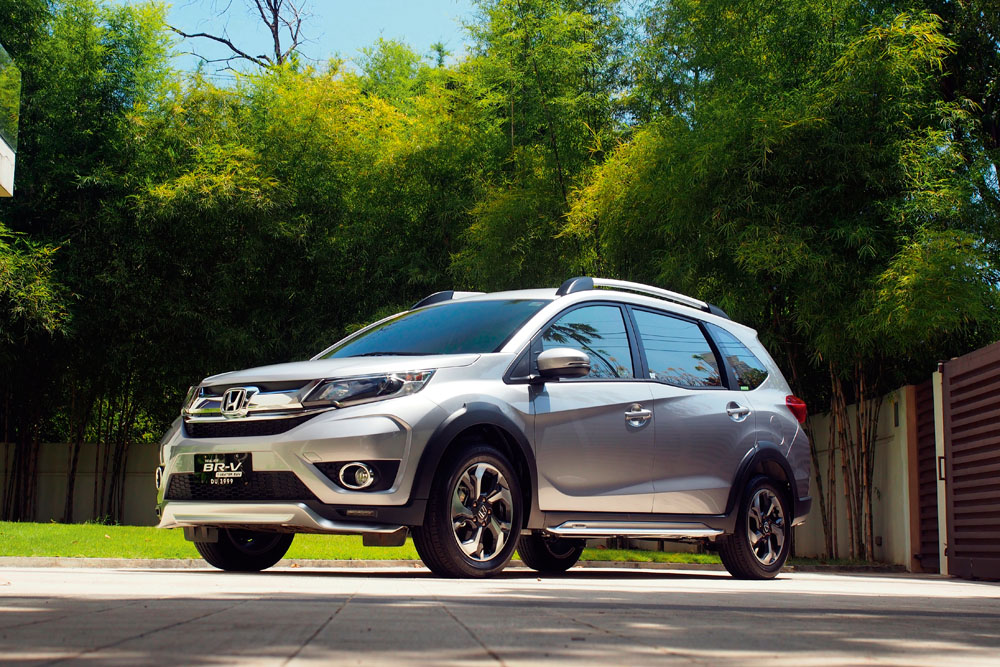
Honda seems to be on a mission to complete the alphabet in its stable of vehicles ending in -RV. In addition to the CR-V, HR-V and WR-V, the Japanese carmaker now adds the BR-V to the list. The Japanese carmaker’s latest offering is a subcompact SUV-cum-minivan that is based on the Jazz platform. It is a vehicle that wants to be everything to everyone. In the local market, it competes directly with mini crossovers like the Ford Ecosport and Nissan Juke in terms of price, but neither of those are able to seat seven, and this is an edge that makes the BR-V a unique animal. And at first gander, it is a rather strange-looking creature.
The BR-V shares a number of design elements from other Honda vehicles. The chrome grille looks like the Solid Wing Face design borrowed from the CR-V. The headlamps are narrow and sleek like in the City and HR-V. The lightning bolt in the rear door’s window frame is a nod to the Odyssey. And of course, the rest of the proportions are similar to its paternal twin, Mobilio. For better or for worse, the BR-V is an amalgam of Honda’s greatest hits.
To make it macho, the bumpers, hood, and door panels are detailed with dimples and creases. Rolling stock are athletic, five-spoke aluminum mags wrapped in 16-inch tires. The BR-V is not as adorably quirky as the Juke, nor is it as sporty as the Ecosport, but somehow it straddles the line between cute and cool.
The BR-V has wide and tall windows that push down the beltline, making for a low-waist profile. It makes the passengers feel less enclosed inside, but outside, it renders a rather fishbowl look. It has the requisite ingredients of an SUV like roof rails, fender flares, and skid plates. Our Modulo unit is enhanced with LED DRL’s, side skirts, and a spoiler. Ground clearance is at 201 mm, making it a bit higher than your typical sedan. The BR-V may be able to ford ankle-deep floodwaters, but Honda did not specify a wading depth. While hardly amphibious, Honda did, however, elevate the air intake, so this vehicle may be able to snorkel its way out of some moderate inundation. The undeniable benefit of this floor height, though, is that it allows for a very comfortable entry into the cabin, with neither ducking nor climbing required.
While the exterior is subjective, there is no arguing that the interior is top-notch. Design and build quality are typical Honda, which means it looks and feels more up-market and expensive than what the price tag suggests. The mid-range version Honda Philippines lent us had black fabric (only the higher-priced variants has leather), but the material did not feel cheap. The head unit is a seven-inch touchscreen with Bluetooth. Below it is the button-controlled, automatic AC, porting cold air to second row passengers who also get their own air vents. Third row occupants are provided with cup holders and smartphone cubbies. Although seven adults is a tight squeeze in this microvan, legroom in all sections is adequate, and thanks to the high ceiling, it feels spacious.


Beneath the short bonnet is a petrol 1.5-liter i-VTEC engine that summons 120 horses and has effective torque of 145 Nm at 4,600 rpm. With displacement and power akin to the Jazz and City, the drive is noticeably perky with only two to three passengers on board. However, with a max complement of seven bodies and some luggage, the powerplant begins to strain and point the needle north of 4,000 rpm to keep up. The Earth Dreams CVT does its best to maintain engine composure as we push the accelerator closer to the floor, but there is no denying physics. On the average, we got about 8 km/L in city traffic and about 12 on the highways.


The steering feels detached and electronic, and it dashes any off-roader ambitions, as the marketing materials otherwise suggest. The upside is that it is ridiculously effortless as a daily driver. Being small and narrow has its advantages, as well, as the BR-V has a steering radius of 5.6 m. The BR-V has commonplace McPherson struts in the front and torsion beams in the back, but the elevated height dispels the bumps and crevices of broken asphalt.


Honda usually prices their inventory slightly higher than the competition, but there’s good news here. Just like the Mobilio, the BR-V is temptingly affordable, beginning at only P989,000 for the 1.5S. Our test unit with the bodykits is dubbed the S Modulo, and it costs only a tad more at P1.035 million. The Navi variant, which has GPS, sells for P1.119 million, and the top of the line version Navi Modulo tops out at P1.185 million.
The BR-V is a sheep in wolf’s clothing. It is a Mobilio wrapped in aggressive and “SUV-fied” sheet metal. However, anyone who has bought delicacies from Japan’s pastry shops can attest: packaging is everything. The BR-V’s looks alone would entice a lot of budget-conscious breadwinners. If I were a family man shopping for a budget seven-seater that hovers around the one million mark, and the other given choices were the Toyota Avanza, the Suzuki Ertiga, or even Honda’s own Mobilio, I would get the one that looks the least like a microvan, and that would lead me straight to the open doors of the BR-V. It is a gambit that seems to have worked in Honda’s favor so far, with waiting lists stretching out of showroom doors and around the corner.
Honda hit the ball right out of the park with the BR-V, and with 22 letters left in the alphabet, we are excited to see what they would come up next in their Really Versatile lineup.






































